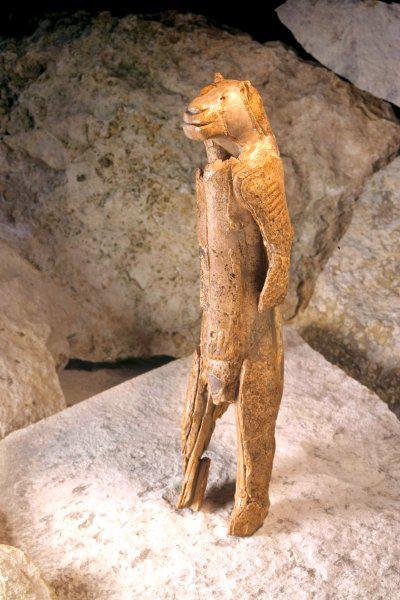The Lion-Man figurine from Hohlenstein-Stadel cave in southwestern Germany is one of the oldest and most spectacular Paleolithic figurines. It is approximately 33,000 years old and was carved from mammoth tusk. When discovered in 1939, it was in hundreds of small pieces which fit together with this result:

The Lion-Man is back in the news because nearly 1,000 additional pieces have been found. As reported by Spiegel, the additional pieces may help resolve an unfruitful debate:
The poor condition of the figurine has only made it more mysterious. Is it meant to represent a mythical creature, or a shaman hiding under an animal hide? The genitalia are unrecognizable. German archeologist and Upper Paleolithic expert Joachim Hahn has interpreted the small plate on the abdomen as a “penis in a hanging position.” Elisabeth Schmid, a paleontologist, classified it as a pubic triangle.
It was the beginning of a bitter dispute over the gender of the small idol that erupted in the 1980s and continues to this day. The statue has been made into an “icon of the women’s movement,” says Kurt Wehrberger of the Ulm Museum, the owner of the precious object.
Those who believe that the Lion Man is in fact a woman are convinced that primitive societies were matriarchal. They contend that women of the period, instead of standing obediently by the cooking fire and watching over the children, hunted mammoths and set the tone when it came to rituals and the priesthood. But is this true?
Even if the new pieces allow us to determine gender, this single figurine won’t say much about the societal structure of the presumably small group who used the cave. It certainly won’t tell us anything about the structure of Paleolithic societies that were spread widely in space and time.
If the ethnohistoric record is any guide, Paleolithic hunting-gathering societies would not have been gender-fixed or sex-determined. There may have been a rough sexual division of labor as there seems to be among most foragers, but this division doesn’t determine matriarchy or patriarchy. To give but one example, Sioux war chiefs who married Cheyenne women would join the wife’s band. Simple dichotomies such as patriarchy/matriarchy can’t even begin to capture the resulting complexities.
These kinds of things are fluid and differ from place to place, often in accord with local traditions. It seems safe to say that during the long course of the Paleolithic, there was no essential societal structure and we can’t generalize from a single sample such as the Lion-Man or Lioness-Woman.


